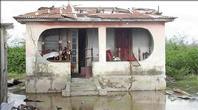By Howard Campbell, Gleaner Writer 
A house damaged by Hurricane Ivan on September 10. - Ian Allen/Staff Photographer
HERE ARE some of the main disaster-prone parishes in the country and how they were affected by the hurricane. They are among the areas that will need the attention of the Danville Walker-led Office of National Reconstruction:
ST. MARY: The banana industry, which is synonymous with the parish, "is 100 per cent wiped out" according to Bobby Montaque, the Mayor of Port Maria and Councillor for the Carron Hall division.
Mr. Montaque told The Sunday Gleaner that St. Mary's most fertile banana settlements in Annotto Bay, Fellowship Hall, Hartlands and Pembroke Valley were ravaged by Hurricane Ivan. At Enfield and Richmond in the parish's eastern side, cocoa farmers reportedly took a beating while in the western towns of Bonnie Gate, Decoy, Goshen, Guys Hill and Top Pen, coffee growers also lost heavily.
The St. Mary Parish Council has established preliminary registration points for farmers to report the damage done to their properties; these claims will be assessed by the Ministry of Labour and Social Security and the Rural Agricultural Development Authority (RADA). As late as Friday, Mr. Montaque says the entire parish was without electricity with most persons still without water; five of the 97 shelters were still open.
CLARENDON: This parish, which has been pounded by heavy rains during the past two years, took another battering. Eight persons reportedly died in Clarendon, with all of the deaths taking place in the fishing community of Portland Cottage to the south; nearby communities of Kemps Hill, Lionel Town, Mitchell Town and Water Lane, which are also largely dependent on the fishing trade, did not escape Hurricane Ivan's savagery. "There's not one house in that community that has not been touched," said a co-ordinator at the Clarendon Parish Council. Extensive damage has also reported in northern towns such as Chapelton, James Hill, Kellits and Mocho, which are driven by vegetable farming.
HANOVER: Farmers and homeowners took a beating in Hanover, sandwiched by the popular tourist stops of Montego Bay in St. James and Negril in Westmoreland. Alvin Graham, Secretary Manager at the Hanover Parish Council, told The Sunday Gleaner that the farming districts of Dias, Kingsdale (producers of bananas and yams) and Logwood (sugar, vegetables) in the west, experienced flooding. In Lucea, the parish's commercial centre and chief town, Mr. Graham reports that there is extensive damage to homes in the adjoining communities of Esher, Johnson Town and Malcolm Heights.
PORTLAND: The eastern tip, says Fay Neuville of the Portland Parish Council, fared worst. There are downed trees, electricity poles and blown-off roofs in the communities of Fruitful Vale, Hector's River, Manchioneal and Kensing-ton, all located near to the St. Thomas border. There is no water nor electricity in the Port Antonio area which has also been affected by fallen trees and utility poles. Five of the 60 shelters in Portland are still open.
ST. ANN: This was one of the parishes hardest hit by Ivan's deadly 24-hour surge. According to Alvin Clarke, disaster co-ordinator at the St. Ann Parish Council, the southern region suffered most damage. There was major flooding in the districts of New Hall, Cascade, McNie, John Reid and Bohemia where many residents were forced to take refuge in shelters after their homes were covered by 30 feet of water. These communities are located near to the Clarendon border and many of the inhabitants depend on farming for their livelihood. As many as 4,000 persons were housed at shelters when Ivan was at his most destructive. At press time, 15 shelters were still open.
ST. CATHERINE: Homes were most affected in this parish, says Yvonne Mundell of the St. Catherine Parish Council. Roofs were blown off houses in towns like Big Pond, Ginger Ridge, Glengoffe and Guys Hill, which are found in the hilly region, as well as low-lying areas including Old Harbour Bay. Homes in Ewarton, Linstead, Lluidas Vale, Mount Rosser, Polly Ground and Sligoville were also damaged. The Bog Walk Gorge, which links St. Catherine to the north coast, experienced flooding.
ST. JAMES: The south and east central region of the parish bore the brunt of Hurricane Ivan's destruction, says Fay Headley, Disaster Preparedness Co-ordinator at the St. James Parish Council. The communities of Mocho, Sweet-water, Tangle River and Vaughns-field, best known for banana farming and the rearing of livestock, were devastated by land slippage; many homes lost their roofs. In the east central area, where many persons depend on poultry farming, the towns of Barry Town, Camrose, Chatham, Liliput and Springmount were hard-hit by flooding.
ST. THOMAS: This is a parish that has traditionally been at the receiving end of unstable weather. Most of the damage from Hurricane Ivan took place in Beacon Hill to the east and Penline Castle and Albion Mountain in the west where there was extreme flooding and land slippage. Millicent Blake, parish co-ordinator at the St. Thomas Parish Council, says most of St. Thomas is without drinking water and electricity. At press time, 15 of the 44 shelters in St. Thomas remained open, acting as a temporary home to over 400 persons.










